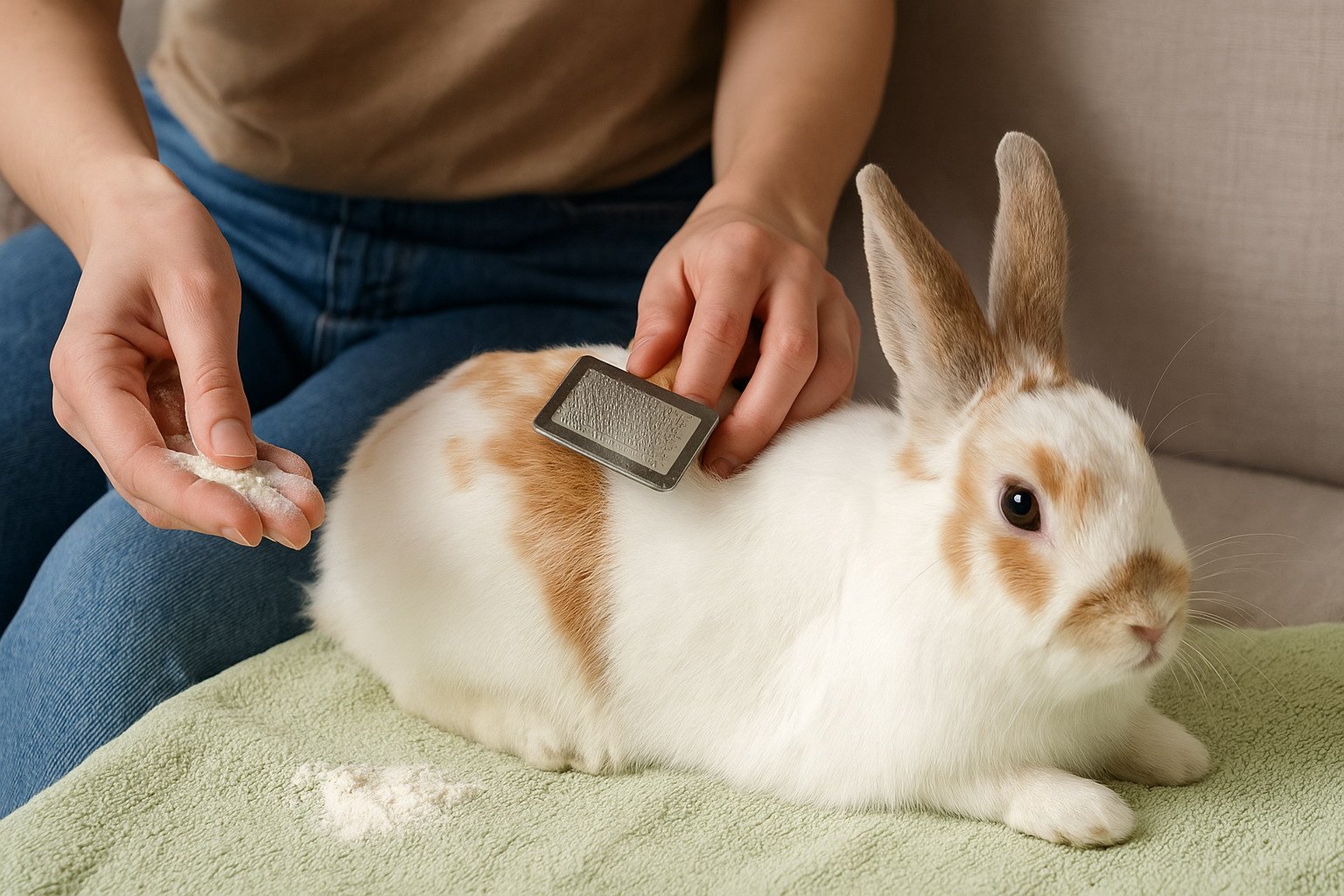Caring for rabbits involves more than just providing food and shelter — it also means ensuring they stay clean and healthy. However, giving rabbits a traditional water bath is not only unnecessary but can be extremely harmful. Unlike other pets, rabbits are delicate creatures with sensitive skin and dense fur that traps moisture. Instead of water baths, rabbit owners should explore safer bath alternatives that maintain cleanliness without risking their rabbit’s health.
In this guide, we will uncover the best bath alternatives for cleaning rabbits, explain why conventional baths are dangerous, and provide rabbit-safe methods to keep your furry friend clean and comfortable.
In This Article
Why Traditional Baths Are Dangerous for Rabbits
Many well-meaning pet owners assume that rabbits need regular baths like cats or dogs. In reality, bathing rabbits with water is one of the most harmful practices you can impose on them. Here’s why:
Risks of Bathing Rabbits:
| Danger | Description |
| Hypothermia | Rabbit fur takes a long time to dry, trapping moisture and causing rapid body heat loss. This can lead to hypothermia, which is life-threatening. |
| Stress-Induced Shock | Rabbits are prey animals with sensitive nervous systems. A sudden bath can cause extreme panic and sometimes lead to fatal shock. |
| Respiratory Issues | Wet fur can lower a rabbit’s body temperature, increasing susceptibility to respiratory infections. |
| Skin Irritation | Rabbit skin is extremely delicate and can become irritated by water, shampoos, or even vigorous handling during a bath. |
Quote from the House Rabbit Society:
“A wet rabbit is a terrified rabbit.“
The Science Behind Rabbit Fur
Rabbit fur is unique. It is thick and insulating, but it does not dry quickly. This makes them especially prone to cold-related illnesses if they get wet. Moreover, rabbits meticulously groom themselves and rarely need external help unless they are sick, injured, or dirty due to environmental factors.
When Does a Rabbit Need Cleaning?
While regular water baths are harmful, there are situations where rabbits do need cleaning. However, it is crucial to approach these moments with care and proper techniques.
Common Scenarios That Require Cleaning:
- Urine Scalding: When urine stains fur, causing skin irritation.
- Fecal Build-Up: Especially in long-haired breeds or rabbits with digestive issues.
- Matted Fur: Often around the tail, hindquarters, or feet.
- Mobility Issues: Older rabbits or those with arthritis may struggle to groom themselves.
- Obesity: Overweight rabbits may have trouble reaching certain areas to clean.
- Illness or Incontinence: Health issues that cause the rabbit to soil themselves frequently.
Key Signs a Rabbit Needs Cleaning:
- Persistent odor despite regular grooming.
- Visible dirt, feces, or urine on the fur.
- Matted or clumped fur, particularly near the rear.
- Discomfort or excessive scratching.
- Skin redness or irritation.
Table: Rabbit Cleaning Needs vs. Cleaning Frequency
| Situation | Recommended Cleaning Method | Frequency |
| Urine Stains | Spot Cleaning | As needed |
| Fecal Build-Up | Dry Bath / Spot Cleaning | As needed |
| Mobility or Obesity Issues | Regular Grooming & Spot Clean | 2-3 times per week |
| Matted Fur | Fur Trimming | When mats are detected |
| General Grooming | Brushing | 1-3 times per week |
Important Note:
If your rabbit consistently needs cleaning, it may be a sign of an underlying health problem. Consult a rabbit-savvy veterinarian to address the root cause.
Dry Bathing: A Safe Alternative for Cleaning Rabbits
One of the most effective and safe bath alternatives for cleaning rabbits is dry bathing. This method allows you to remove dirt, grease, and feces without using water.
What Is Dry Bathing?
Dry bathing involves using rabbit-safe cornstarch-based powder to absorb moisture and loosen dirt, making it easier to brush out. Never use talcum powder or products with added fragrances, as these can irritate your rabbit’s skin and lungs.
How to Perform a Dry Bath:
- Prepare a Soft Surface: Place your rabbit on a towel or soft mat to prevent slipping.
- Apply Cornstarch Powder: Gently sprinkle cornstarch (unscented, pure) onto the soiled area.
- Massage Gently: Carefully work the powder into the fur using your fingers to break up dirt or feces.
- Brush Thoroughly: Use a fine-tooth comb to remove the loosened debris and excess powder.
- Reward Your Rabbit: Offer a healthy treat to help your rabbit associate cleaning with positive experiences.
Precautions:
- Avoid applying powder near the rabbit’s nose, mouth, or eyes.
- Keep sessions short to minimize stress.
- If mats are too tight or the skin appears irritated, consult a vet.
Dry bathing is an excellent option for occasional clean-ups, but it should not replace regular grooming.
Spot Cleaning with Damp Cloth or Baby Wipes
For minor messes, spot cleaning is one of the easiest bath alternatives for cleaning rabbits. This method focuses only on the dirty areas without wetting the entire body.
Best Tools for Spot Cleaning:
- Soft, damp washcloths with warm (not hot) water.
- Alcohol-free, unscented baby wipes.
- Rabbit-specific grooming wipes available in pet stores.
How to Spot Clean a Rabbit:
- Gently hold the rabbit in a secure position.
- Lightly wipe the soiled area with a damp cloth or wipe.
- Pat the area dry immediately with a soft towel.
- Offer comfort and praise to reduce stress.
Key Tips:
- Never soak the fur. The goal is to use minimal moisture.
- Use a dab and wipe motion rather than rubbing, which can cause skin irritation.
- Always inspect for skin damage or infections during cleaning.
“A small mess requires a small solution.” — Spot cleaning is effective, fast, and far less stressful for rabbits than a full bath.
Brushing and Grooming as Preventative Cleaning
Regular grooming is the most powerful preventative measure you can take to keep your rabbit clean and healthy without resorting to dangerous bathing.
Benefits of Frequent Brushing:
- Removes loose fur and debris.
- Prevents fur matting, especially in long-haired breeds like Angoras and Lionheads.
- Reduces the risk of hairball blockages (trichobezoars), which rabbits cannot vomit.
Grooming Frequency by Breed:
| Rabbit Breed | Recommended Brushing Frequency |
| Short-Haired Rabbits | 1-2 times per week |
| Long-Haired Rabbits | Daily |
| Molting Rabbits | Daily during shedding periods |
Essential Grooming Tools:
- Slicker brush for loosening fur.
- Fine-tooth comb for detailed grooming.
- Fur clippers or blunt-tip scissors for trimming problem areas.
Additional Grooming Practices:
- Inspect the hindquarters and feet for dirt or mats.
- Regularly check ears, nails, and scent glands.
- Create a calm grooming environment to prevent anxiety.
Case Study:
Owner’s Experience: Emily, a rabbit owner from Melbourne, noticed her rabbit, Daisy, was struggling with constant fur clumps and dirty patches. By switching to daily brushing and weekly dry baths, Daisy’s coat became clean, shiny, and mat-free within two weeks — no stressful water baths needed.
Cleaning the Scent Glands
Many rabbit owners overlook the importance of cleaning the scent glands, yet this is vital to prevent discomfort and odor.
What Are Rabbit Scent Glands?
Rabbits have two small scent glands located on either side of their genitals. These glands can accumulate a dark, waxy substance that, if left uncleaned, can cause odor and attract flies.
How to Clean Scent Glands Safely:
- Position the Rabbit Comfortably: Place the rabbit on its back in a secure, calm hold (the “bunny burrito” method with a towel can help).
- Locate the Glands: Gently part the fur near the genital area to find the scent glands.
- Remove Debris: Use a damp cotton swab or a soft cloth to gently wipe out the buildup.
- Be Gentle: Avoid digging or poking too deep as this can hurt the rabbit.
Signs of Scent Gland Issues:
- Strong, unpleasant odor.
- Visible dark buildup.
- Signs of discomfort or excessive grooming in the area.
Cleaning the scent glands every few weeks is usually sufficient for most rabbits.
Fur Trimming for Hygiene Maintenance
When rabbits struggle to stay clean, fur trimming can be an excellent maintenance solution.
When Fur Trimming Is Necessary:
- Long-haired breeds prone to matting.
- Rabbits with mobility issues.
- Persistent urine or fecal stains around the bottom or tail.
How to Trim Fur Safely:
- Use blunt-tipped scissors to prevent accidental cuts.
- Only trim small amounts of fur at a time.
- Focus on areas near the rear, feet, and tail.
- If the mats are close to the skin, seek help from a professional groomer or vet.
Pro Tip:
Never attempt to cut tight mats close to the skin yourself — rabbit skin is extremely thin and can tear easily.
Dealing with Stubborn Stains
Some stains, especially urine scald or fecal stains, may require extra care.
Rabbit-Safe Cleaning Solutions:
- Diluted white vinegar (50:50 water mix): Effective for mild urine stains.
- Veterinary-recommended cleaning sprays: Always confirm they are safe for rabbits.
Cleaning Process:
- Apply the solution lightly using a damp cloth.
- Gently dab the stained area, avoid scrubbing.
- Dry thoroughly to prevent moisture retention.
Products to Avoid:
- Human shampoos or soaps.
- Scented baby wipes.
- Talcum powders or sprays with alcohol.
Rabbits have extremely sensitive skin; always choose the mildest possible cleaning agents.
Litter Box Training to Minimize Cleaning Needs
One of the best ways to reduce how often your rabbit needs cleaning is through proper litter box training.
Benefits of Litter Training:
- Keeps your rabbit’s fur cleaner.
- Reduces the chances of urine scalding.
- Simplifies cage and home maintenance.
Tips for Successful Litter Training:
- Place the litter box in the rabbit’s preferred corner.
- Use rabbit-safe litter (avoid clumping clay-based litters).
- Reward the rabbit with treats when they use the box.
- Clean the box regularly to encourage consistent use.
By improving litter habits, you can significantly reduce the need for physical cleaning and keep your rabbit’s environment hygienic.
When to Seek Veterinary Help
Sometimes, home cleaning methods are not enough, and professional veterinary care becomes essential.
When to Call a Vet:
- Persistent bad odor despite cleaning.
- Severe matting or hard-to-reach stains.
- Signs of skin infection, redness, or sores.
- Symptoms of flystrike (maggots on the skin).
- Recurring hygiene issues linked to obesity or illness.
“If in doubt, always consult a rabbit-savvy vet.”
Rabbits with health problems may require special grooming assistance and medical treatment to address underlying causes.
Conclusion
Bath alternatives for cleaning rabbits are not just convenient — they are essential for rabbit health and safety. Traditional water baths pose serious risks like hypothermia, stress-induced shock, and skin irritation.
Instead, use:
- Dry bathing with cornstarch powder.
- Spot cleaning with wipes.
- Regular brushing to prevent fur matting.
- Proper fur trimming.
- Scent gland maintenance.
By understanding when and how to clean your rabbit safely, you can ensure your furry companion stays healthy, comfortable, and stress-free.
Remember: prevention is key. Regular grooming, a clean environment, and proper litter training will dramatically reduce the need for intensive cleaning.

